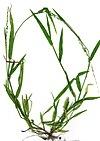Gynerium
| Gynerium | |
|---|---|

| |
| Scientific classification | |
| Kingdom: | |
| (unranked): | |
| (unranked): | |
| (unranked): | |
| Order: | |
| Family: | |
| Subfamily: | |
| Tribe: | Gynerieae Sánchez-Ken & L.G. Clark (2001)
|
| Genus: | Gynerium |
| Binomial name | |
| Gynerium sagittatum | |
| Synonyms[2] | |
| |
Gynerium is a monotypic genus of Neotropical plants in the grass family, native to Mexico, Central America, South America, and the West Indies.[3][4] It is classified in its own tribe Gynerieae.[5]
The sole species in the genus is Gynerium sagittatum, a tall grass that grows up to six metres (twenty feet) high. It is a very vigorous species that grows into a considerably dense mass of vegetation. The species is known as "cana-do-rio", "cana-flecha", "cana-frecha", "ubá" and "cana-brava" in Brazil, and "caña brava" in Peru, "tañil" in Cahabon, Alta Verapaz, Guatemala and other Spanish speaking countries. It is known in English as "wildcane"[6] or "wild cane", while "arrow cane" is less common (sagitta is Latin for arrow).
Description
The stems are straight and erect, the lower part is covered with "vainas" from the fallen leaves, while in the middle part the leaves are arranged in fan shaped groups. The upper part, round and thin, stiff on the outside and soft on the inside, develops a large bloom at the top.
There are many varieties in the plant's stems. The bark zone, which is the main factor in the unusual height, functions as a water distribution system, transporting water from the underground roots to the superior part of the plant including the leaves. This vital function occurs at any season of the year.
Ecology
Being one of the first plants to colonise open areas, G. sagittatum is an important pioneer species that reaches new sites via wind-distributed seeds. Once established, it spreads vegetatively, and is found usually near rivers and lakes, and even beaches.
Uses
- In Colombia its straw is used to create different accessories including the traditional sombrero vueltiao, symbol of Colombia.
- In Brazil, the lower and middle parts are used in cheap or improvised fences, and in cheap trellises for climbing plants and cultivation of tomato. The upper part, with the bloom at the top, is sometimes used in decoration. The more homogeneous section of the upper part is used to make arrows and birds cages.
Diversity
- Species[2]
The only known species is Gynerium sagittatum, - widespread from northern Mexico to Paraguay.[7][8][9][10]
- Varieties[2]
Three varieties are recognized:
- Gynerium sagittatum var. glabrum Renvoize & Kalliola - Bolivia
- Gynerium sagittatum var. sagittatum - from northern Mexico to Paraguay
- Gynerium sagittatum var. subandinum Renvoize & Kalliola - Bolivia
- formerly included[2]
see Austroderia Cortaderia Chusquea
References
- ^ Tropicos, search for Gynerium
- ^ a b c d Kew World Checklist of Selected Plant Families
- ^ Willdenow, Carl Ludwig von ex Palisot de Beauvois, Ambroise Marie François Joseph 1812. Essai d'une Nouvelle Agrostographie 138-139 description in Latin, commentary in French
- ^ Willdenow, Carl Ludwig von ex Palisot de Beauvois, Ambroise Marie François Joseph 1812. Essai d'une Nouvelle Agrostographie plate XXIV (24), figure VI (6 a-d) line drawings of Gynerium sagittatum; figure captions on caption page 16
- ^ Soreng, Robert J.; Peterson, Paul M.; Romschenko, Konstantin; Davidse, Gerrit; Zuloaga, Fernando O.; Judziewicz, Emmet J.; Filgueiras, Tarciso S.; Davis, Jerrold I.; Morrone, Osvaldo (2015). "A worldwide phylogenetic classification of the Poaceae (Gramineae)". Journal of Systematics and Evolution. 53 (2): 117–137. doi:10.1111/jse.12150. ISSN 1674-4918.

- ^ NRCS. "Gynerium sagittatum". PLANTS Database. United States Department of Agriculture (USDA). Retrieved 9 May 2015.
- ^ Boggan, J. Funck, V. & Kelloff, C. (1997). Checklist of the Plants of the Guianas (Guyana, Surinam, Franch Guiana) ed. 2: 1-238. University of Guyana, Georgetown
- ^ Nelson Sutherland, C.H. (2008). Catálogo de las plantes vasculares de Honduras. Espermatofitas: 1-1576. SERNA/Guaymuras, Tegucigalpa, Honduras
- ^ Hokche, O., Berry, P.E. & Huber, O. (eds.) (2008). Nuevo Catálogo de la Flora Vascular de Venezuela: 1-859. Fundación Instituto Botánico de Venezuela
- ^ Giraldo-Cañas, D. (2011). Catálogo de la familia Poaceae en Colombia. Darwiniana 49: 139-247.

